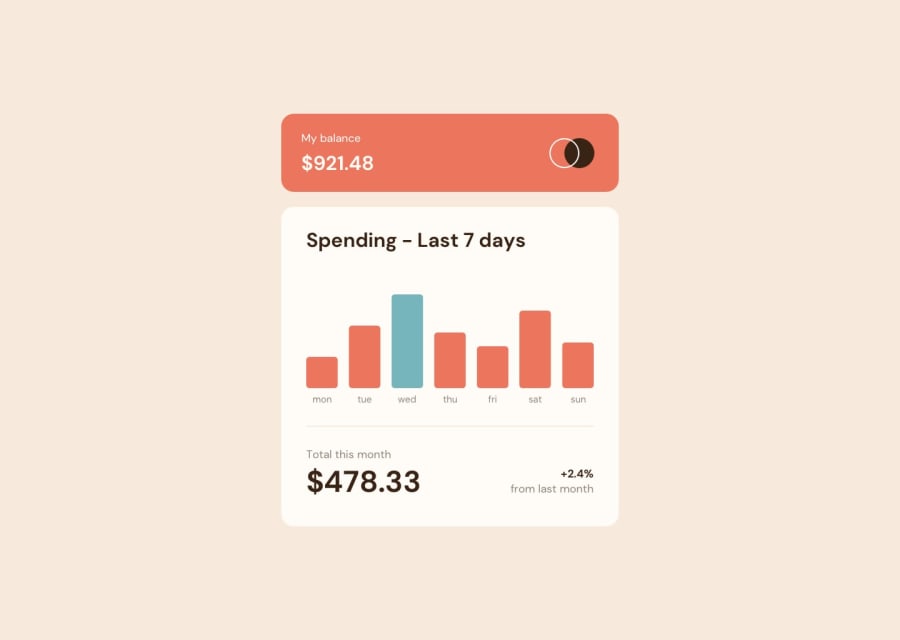
Expenses chart component using HTML, CSS, and Vanilla JavaScript
Design comparison
Solution retrospective
Hi everyone 👋,
Please helps to feedback on how I approach fetching local JSON file using Fetch API with try/catch and async/await instead of fetch().then().catch(). Is there any improvement I should make? And the idea of how to implement chart column growing animation after the height has been set by JavaScript for continued development.
Thanks for the feedback 👍
Community feedback
- @andreasremdtPosted over 2 years ago
Hey @boonyarit-iamsaard,
Congrats on solving the challenge, it's looking really good and close to the design. I like that you didn't use any library or framework for the chart, nice practice exercise :)
A couple of things:
- You don't have any heading in your markup, which could lead to accessibility and SEO issues. I would use an
h1for My balance and anh2for Spending - Last 7 days (though others might reverse the order or use different levels, there's room for discussions). - You could use a
headerelement for thebalance-container, would make it even more semantically correct. - In terms of your JavaScript and data fetching I can't really find anything that needs dior improving, the error handling is solid and everything is nicely structured into reusable functions. One addition I can recommend is checking the HTTP status via
if (response.ok) {...}, because a 404 or many other HTTP "errors" don't throw errors, but your script would still fail. It's always good to think about these edge-cases. So, you could do something like this:
try { const response = await fetch(url); if (!response.ok) { throw new Error(`${response.status}: ${response.statusText}`); } return await response.json(); } catch (error) { throw new Error('Expenses data is not available.'); }Otherwise, nicely done :)
Marked as helpful1@boonyarit-iamsaardPosted over 2 years agoHi @andreasremdt,
First of all, I thank you for your feedback, it means a lot to me as I'm self-taught.
Here are replies to your feedback:
- I'm not so sure where to put the level heading in my markup, so I use the
.sr-onlyclass with it instead. Is that a good practice? - I couldn't agree more to use the
headerelement for thebalance-container. - I was thinking to check
response.okwhen I'm doing the JavaScript part, but I skip it because I thought the Fetch API will throw the HTTP error to the catch block.
Thanks again for the feedback 👍
1@andreasremdtPosted over 2 years agoHey @boonyarit-iamsaard,
You are welcome :) In regards to your heading: using a
.sr-onlyelement is one way of solving it, but the even easier solution would be to replace thedivs around My balance and Spending - Last 7 days with heading elements. I would use anh1for My balance, as to me this seems to be the most important title and it's also the first one on the page (both visually and semantically). And for Spending - Last 7 days, I'd recommend using anh2instead, since it comes below but marks the title of the chart section, so it's also kinda important. Hope this helps.Marked as helpful1@boonyarit-iamsaardPosted over 2 years agoHi @andreasremdt,
Now I understand clearly, thanks👍
0 - You don't have any heading in your markup, which could lead to accessibility and SEO issues. I would use an
Please log in to post a comment
Log in with GitHubJoin our Discord community
Join thousands of Frontend Mentor community members taking the challenges, sharing resources, helping each other, and chatting about all things front-end!
Join our Discord
